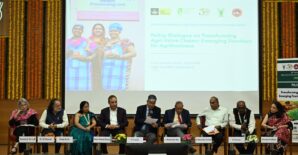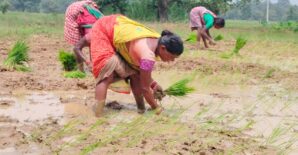Konark Sikka is an intern with IFPRI- South Asia office
Smallholders form the core of the agricultural system in India. Yet, they are marginalized and their problems overlooked. They face rising wages, rural-urban migration as well as growing market and climatic risks. In order to deal with these complex challenges, a “one size fits all” policy may not work.
At the 74th Annual Conference of Indian Society of Agricultural Economics, Dr P K Joshi, Director of the IFPRI South Asia Office, gave a keynote address titled ”Has Indian Agriculture Become Crowded and Risky? Status, Implications and the Way Forward”.
Dr Joshi stressed that the issue is compounded by the growing number of smallholders and their declining areas of operation, which leads to continual shrinking of the size of their landholding. Developing countries, including India, have praised smallholders on their efficiency, promoting them on the belief that “small is beautiful”. Although there is no doubt about their efficiency, there are questions regarding their viability and sustainability due to the steep decline in their holdings without any additional income sources.
Over the past 30 years, the number of smallholders has increased by 70%, with their land share jumping to 45%. However, the total operating area has fallen by 4 million hectares (ha), due to increased urbanization, land degradation and real estate development. Furthermore, smallholders are mostly clustered in areas with high poverty and low urbanization, as well as low scores on other social indicators, such as human development, sanitation and access to toilets. Dr Joshi said that increasing smallholders without appropriate measures would have wide socio-economic and political implications.
The crowding of smallholders not only leads to the overuse of natural resources and over-use of chemical fertilizers, but also leads to a rapid degradation of land and water resources. Dr Joshi indicated that, despite the developments in the markets and value chains in India, smallholders remain at risk because they are left behind due to their lower marketable surplus than large farmers, lower bargaining power, higher transaction costs, greater price volatility and underdeveloped markets in smallholder-dominated areas. Moreover, Dr Joshi said, they are uninformed about markets and financial institutions.
In the public extension system, around 72% of farmers, especially smallholders, are untouched by any source of information delivery system. Those with more access to information sources had more land ownership and irrigated areas. Further adding to the stress is the risk of climate uncertainty. In the past, Dr Joshi said that there had been major risks of drought and flood episodes in South Asia due to climate change, coupled with water shortages and outbreak of water- and mosquito-borne diseases. Such events would cut down productivity and increase prices for staple foods, furthering the burden on smallholders.
Looking at the states of Bihar and Odisha with high concentrations of smallholders (97% and 83%, respectively), they have weak institutions and infrastructure, complex social stratification as well as climate and pest risks, all of which lead to low productivity. Other bottlenecks such as a weak market and credit system, lack of implementation of the Model Market Act as well as a lack of electrification further pull agricultural growth backward, Dr Joshi commented.
On the other hand, diversification toward high-value agriculture as well as several public and private sector initiatives have increased the participation of a large number of smallholders in modern value chains of milk, fruits and vegetables, thus raising their income. Smallholders can benefit with initiatives to bridge yield gaps, promote high-value agriculture, strengthen agro-processing, and create enabling institutions. However, Dr Joshi added, creating job opportunities outside agriculture for smallholders is the ultimate solution to improving their livelihoods.
In his presentation, Dr Joshi highlighted several policy-based ways forward:
1. Land & Labour Reforms: A new land ceiling law for a minimum size of landholding should be implemented in order to prevent further lowering of holding size and fragmenting of landholdings. Labour laws need to be reformed so that industrial and service sectors can absorb surplus manpower from the agricultural sector.
2. Market Reform: Developing markets in areas with more concentrated smallholders would be beneficial, as would adopting a cluster approach while developing markets. Creating institutions, such as contract farming and cooperatives—which link smallholders with markets as well as minimize risk in marketing of agricultural commodities—would help as well.
3. Reform Agricultural Extension System: There is a need for a new cadre of agri-business professionals who should be mandated to develop business plans for farmer groups and link them with service and tech providers as well as markets, especially in smallholder-dominated areas.
4. Minimize Risk: The government should evolve policies and institutions to promote climate-smart agriculture, agricultural insurance and strengthen weather advisory services in order to deal with the risks that climate change portends.
5. Innovations toward pro-smallholders: There needs to be a pro-smallholder thrust in any new agricultural research agenda set out by the national agricultural research system. The time is also right for convergent innovations, related to social mobility, technologies, financing and marketing and processing and retailing
6. Non-Farm Employment Opportunities: Industry and manufacturing needs to be strengthened so that smallholders have means of alternative employment, which allows for poverty reduction.



